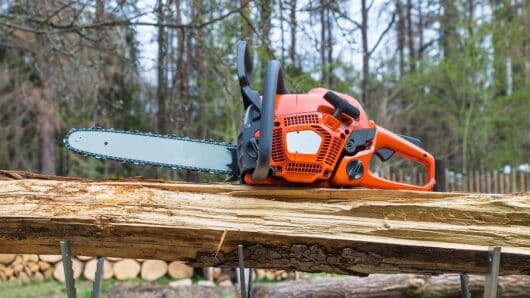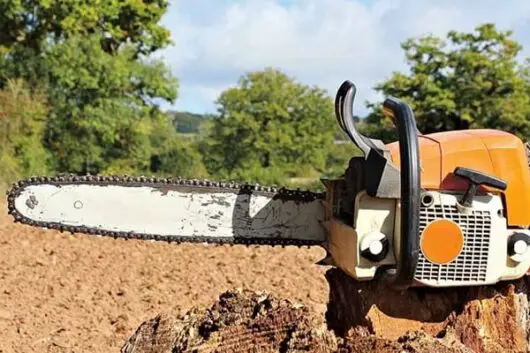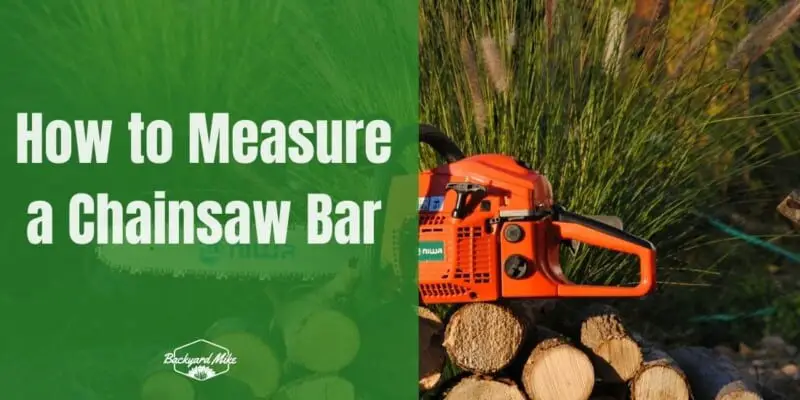Are you looking to measure the bar of your Husqvarna chainsaw, but not sure how? Measuring the bar of a chainsaw can be tricky, but if you have the right tools and follow the proper steps, it can be done with ease. In this article, we’ll provide a complete guide to measuring a Husqvarna chainsaw bar, so you can get the job done quickly and accurately. So, what are you waiting for? Read on to learn how to measure a chain saw bar like a pro!
Understanding chainsaw bars
The guide bar on your Husqvarna chainsaw is the metal part that extends from the body that the chainsaw chain wraps around. The chainsaw bar is typically responsible for providing the platform for attaching the chain and carrying out the cutting, splitting, pruning, and other tasks. If you’re looking to determine the size of your chainsaw bar, you can get a replacement, there are easy ways of measuring the length. Many measurements either refer to the cutting length (which is just how far the chainsaw bar sticks out) or the true length (the full size of the bar). If you’re in the market for a new chainsaw bar, you will want to know how to measure a chain saw bar.
However, you will also want to know the different types of chainsaw bars. There is no point in knowing the right chainsaw length if you end up using the wrong type of bar.

Different types of the chainsaw bars
A chainsaw bar is an integral part of a chainsaw, and there are different types of chainsaw bars commonly used. Here are the different types of chainsaw bars that you should know about.
#1. Solid chainsaw bars
Solid chainsaw bars are made using one piece of solid steel. They are quite tough and strong, and they’re made for dirty, sandy, or rough conditions. However, solid chainsaw bars tend to be more expensive than other types of chainsaw bars. Moreover, as they have to handle so much, they end up getting hot and drain some of the engine’s power. Solid chainsaw bars can be quite heavy, or at least feel heavy to the user. As they are strong, they’re able to resist bending and be effective in long versions.
#2. Laminated chainsaw bars
Laminated bars can be strong and reliable. These aren’t laminated by a coating but they are laminated. They have spot weld marks toward the sides of the chainsaw bar, which keep the two steel pieces of the chainsaw bar together around the steel core.
Laminate bars are light and affordable, but they aren’t as strong as solid chainsaw bars. They are ideal for smaller chainsaws in a non-professional setting. However, they are also great for arborists that have to carry chainsaws up a tree due to their lower weight.
Laminate chainsaw bars function well in 16 to 20-inch lengths. Laminate bars can go up to 24 inches in length. High-quality laminate bars can last a long time and they are highly reliable. Many chainsaw operators keep a laminate bar as a backup in case it is needed.
#3. Hard nose chainsaw bars
Hard-nose chainsaw bars are essentially a sub-category of solid bars. A hard-nose bar will be the quintessential solid bar, as it is made using a single solid piece of metal. They are very sturdy bars made for rough conditions, such as on ranches and in forests.
A hard nose bar comes with a solid tip that doesn’t have a sprocket. The chain will slide over the bar itself on a hard-nosed bar without making use of a sprocket. Hard nose bars that are made using strong alloy are ideal for use in difficult conditions. They’re usually made with a single steel sheet that is completely solid. Further, the hard nose bar tips can be easily reinforced with extra coating or another layer of metal.
#4. Narrow chainsaw bars
Also known as narrow kerf chainsaw bars and typically matched with a narrow kerf chain, Narrow Chainsaw bars are types of bars that are the perfect fit for smaller chainsaws. They require less power from the motor and generate less heat. Arborists often use narrow chainsaw bars much more than other professionals.
Chainsaws having a narrow kerf bar can cut faster than the ones with standard 3/8-inch pitch chains. Further, they also weigh comparatively less and allow for much more maneuverability. You can use them for making smoother cuts in wood, while they produce less sawdust and waste.
However, it is important to remember that narrow chainsaw bars aren’t ideal for general-purpose tree felling and bucking firewood. This is the case as they are not durable enough to run on more powerful chainsaws.

#5. Sprocket nose bars
The standard chainsaw that you purchase today makes use of a replaceable sprocket nose bar. They utilize a rotating sprocket at the tip attached to rivets that the chain runs over. The tip of a sprocket nose bar won’t be solid, unlike the rest of the bar, which might be.
Sprocket nose chainsaw bars are essentially of the laminated type construction and they’re made using separate pieces of metal. The tip of a sprocket nose is replaceable in case it gets damaged, unlike solid bars that require complete replacement.
#6. Carving chainsaw bars
Carving chainsaw bars are typically shorter compared to other types of bars, with the bar lengths ranging from 10 to 14 inches. They’re made from wood artists that have to make precise cuts. The tips of carving, chainsaw bars come with a more pointed shape compared to standard bars. They allow for smaller and narrower cutting with the help of the tip of the chainsaw.
Carving chainsaw bars are much lighter and allow for more flexibility than other bars. They can be used in clearing homeowner’s yards as well as for small tree and bush removal.
How to measure a chain saw bar?
Find the cutting length
Step 1: Preparation for measuring the cutting length
- First, you need to unplug the spark plug such that your Husqvarna chainsaw doesn’t automatically start
- Set your Husqvarna chainsaw on a flat surface such that the handle is facing up
- Locate the bolts or screws holding the top cover of your chainsaw’s body
- Use either a screwdriver or wrench for loosening them
- Look for a black wire plugging into the circular port under the cover
- Lastly, pull the wire out of the port for disconnecting power from the spark plug
Note: Remember not to measure the bar length while the spark plug wire is attached. This way, you’ll be preventing the Husqvarna chainsaw from starting while you are working on it. Further, the location of the bolts or screws might vary depending on your chainsaw model
Step 2: Measure the chainsaw bar
- You should measure the top of the chainsaw bar to where it is entering the body for accurate cutting length
- Begin at the end of the tape measure where the bar goes inside the main chainsaw body
- Extend the measure tape until you’ve reached the tip of the chainsaw bar and record your measurement
- Round off the measurement to the nearest inch for finding the cutting length of the bar
For instance, if the measurement you have taken is 135⁄8 inches, then the cutting length will be 14 inches. Remember, the cutting length might also be referred to as length, effective length, or usable length. The average cutting lengths of chainsaws are 14 inches, 16 inches, 18 inches, and 20 inches.
Find the true length
Step 1: Preparation for measuring the true length
- Tale off the clutch cover for removing the bar
- Locate the two nuts on the right side of the chainsaw holding the clutch cover in place and then use a wrench for unscrewing them
- Once you’ve removed the nuts, you should put the cover straight off the chainsaw for exposing the rest of the bar
- Then, move the bar forward such that it releases from the clutch before you pull it off of the bolts
- If your chainsaw has a brake, ensure that it is in a locked position before you remove the clutch cover, or it’ll be difficult to put it back on
Step 2: Measure the true length
- You should measure the chainsaw bar from end to end for finding its true length.
- Start the tape measure on one end of the bar before extending the tape to the tip on the other side for finding the true length
- Round off the measurement to the nearest inch to know the accurate true length of the chainsaw bar
For instance, if the measurement is 161⁄3, then the true length of your Husqvarna chainsaw bar will be 16 inches. Standard chainsaw bar lengths will be between 8 to 24 inches. The true length of the chainsaw bar has to be longer than the cutting length.
FAQs
How do I measure the bar on a chainsaw?
Measuring the bar on a chainsaw is relatively simple. First, check the markings on the bar itself to determine the length. If the bar does not have any markings, you can use a ruler or measuring tape to measure it from end to end. For a Husqvarna chainsaw, the bar length is often printed on the side of the bar, near the center.
What is the best way to measure a Husqvarna chainsaw bar length?
The best way to measure a Husqvarna chainsaw bar length is to check the markings on the bar itself. If the bar does not have any markings, you can use a ruler or measuring tape to measure it from end to end. For a Husqvarna chainsaw, the bar length is often printed on the side of the bar, near the center.
What should I look for when measuring a chain saw bar?
When measuring a chain saw bar, you should look for any markings that indicate the bar length. Additionally, you should check that the bar is perfectly straight and not bent or warped. Finally, you should check that the bar is securely attached to the chainsaw and that the chain tension is properly adjusted.


